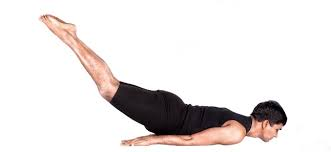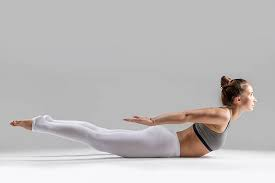5 Incredible Health Benefits of Locust Pose (Shalabhasana)
- Blog
- /
- Yoga Poses and Sequences
- /
- 5 Incredible Health Benefits...

Shalabhasana (Locust Pose): A Comprehensive Guide
The term Shalabhasana derives from the Sanskrit word “Shalabh,” meaning locust or grasshopper, an insect that dwells on the ground. The pose resembles this insect, hence its name.

Health Benefits of Shalabhasana
The Shalabhasana offers numerous health benefits, including:
- Strengthens Abdominal and Back Muscles: This pose significantly strengthens and tones the abdominal and back muscles. The asana exerts pressure on these areas, stimulating muscle health and enhancing flexibility. It also reduces stiffness in the spinal cord.
- Improves Digestion: Regular practice of Shalabhasana promotes better digestive health. It massages the inner intestines and stomach, aiding digestion and providing relief from constipation. The pose boosts enzyme and digestive juice production, enhancing overall digestive function.
- Promotes Better Blood Circulation: Lying down To reduces pressure on the cardiovascular system, allowing smooth blood flow throughout the body. It supports cardiovascular health and helps prevent conditions like high cholesterol and heart disease.
- Increases Sexual Stamina: Studies suggest that Shalabhasana can enhance sexual stamina and strength over time. The pose stimulates the sexual organs, increasing blood flow and improving performance.
- Reduces Stress and Tension: Beyond physical benefits, Shalabhasana fosters mental calmness and concentration, contributing to overall stress reduction and mental peace.
Methods to Achieve Shalabhasana

Method 1:
- Lie on your abdomen with your body firmly pressed to the ground and your hands by your sides.
- Inhale and lift your legs and upper torso simultaneously.
- Use the strength of your inner thighs to lift your legs without bending your knees. Your body weight should rest on your abdomen and lower ribs.
- Hold the pose for about a minute, then slowly release.
- Repeat the process for each leg separately, alternating movements without jerking. Perform at least 4 to 5 repetitions for each leg.
Method 2:
- Lie on your stomach with your abdomen pressed to the ground. Straighten your right hand and touch your ear and head, keeping the right hand on the ground.
- Place your hands on your back.
- Inhale and lift your head and right hand above ground level.
- Hold the position, then inhale and exhale while returning to the initial position.
- Repeat with the alternate hand and foot.
Method 3:
- Lie on your stomach.
- Extend both hands back and hold one wrist with the other.
- Inhale and lift your chest, looking upward.
- Gradually lift your body from both sides.
- Exhale and return to the starting position.
Modifications for Shalabhasana
To enhance the benefits of Shalabhasana, consider these modifications:
- Place a folded blanket under your hips or thighs, or use a bolster to support your thighs and rib cage. This aids those who find it challenging to keep their feet elevated and hinge their body on the lower abdomen.
- Spread your arms to the sides or overhead to support your lower back.
- Integrate preparatory poses such as the Cobra or Snake Pose into your Vinyasa flow. Follow up with the Bow or Crocodile Pose as an after-pose.
Read More – The Health Benefits of Salabhasana (Locust Pose)
For a deeper understanding of these poses and more, explore our Yoga Teacher Training in India.
Conclusion
Shalabhasana, or Locust Pose, is a powerful asana that offers a range of benefits from strengthening core muscles to enhancing digestion and promoting cardiovascular health. By incorporating modifications and integrating complementary poses, you can maximize the benefits of this practice. For more insights and comprehensive training on yoga practices, including advanced poses and techniques, visit our Yoga Teacher Training India ,200 Hour Yoga Teacher Training or 300 Hour Yoga Teacher Training and explore our Ayurveda Retreat In Kerala. Discover how other asanas can transform your health and well-being.








